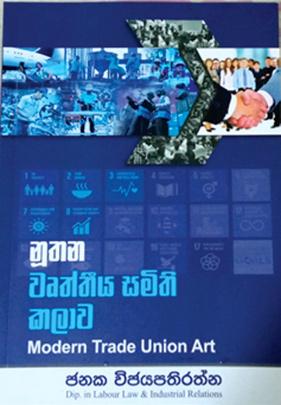
The fast-changing socio-economic, cultural, and political landscape across the world, which has inevitably brought paradigm shifts in many spheres of human life, notably spawned by massive economic reforms of various forms, has impacted reinvention of the concept of trade unionism all over the world.
The classic definition of the function or role of trade unions was given by Webb and Webb (1894): “a continuous association of wage-earners to maintain and improve the conditions of their working lives.” But, does it give a coherent, well-grounded meaning for us to understand the intricate nature of man-work relationships of the modern-day society?
In this context, it is heartening to see that a young veteran trade union leader, the President of Nidahas Sevaka Sangamaya (Mother Association), Janaka Wijayapathirathna, has blazed a trail to dig deep into this situation in his book “Modern Trade Union Art” to come up with a new perspective of who a modern-day trade unionist is and the essential functions of a trade union on the one hand and tearing the anachronistic concepts of unionism into shreds on the other. For me, his book is an eye-opener of different aspects of trade unionism and a vehement attack against those who, with their self- uplifted souls, seem to rule the roost in the world of trade unionism with no benefits whatsoever for the working class.
Novel approach
The book in its entirety is a novel approach to trade unionism. And his arguments are more compelling today and will soon get popularity across the country’s political spectrum. His views seem to stem from his wealth of experience in the field.
The approach and the style he employs for the book take the reader through a journey right from the beginning of the origin of trade unionism, how it has been established in the constitution and other relevant acts of the country to the practical and pragmatic arenas of how it must be used today not only for developing the living standard of the masses but also for the nation-building.
Upon deep reflection on the functions of trade unions of the country, the writer categorically emphasises that trade union leaders, especially those representing the workers in the most vulnerable economic sectors providing public service, have to be conscious of the social and national responsibility. He elaborates the point that they must get rid of orthodox, traditional unionising to develop positive attitudes towards their members and the nation.
He stresses an essential fact that the primary responsibility of the trade unionist today is to comprehend the social commitment of identifying and dealing with the authentic problems of their members devoid of the so-called theoretical class division and political affiliations.
While providing a comprehensive account of the collective bargaining process by the trade unions, he focuses on getting the members’ approval for the claims they make. Admittedly, some present-day campaigns launched by trade unions are merely the actions of the pressure imposed by some political parties for gaining their political elements or haphazard decisions taken by a few office-bearers of the union.
He vividly accentuates that strikes must be the last resort when all the other alternative attempts fail. Nevertheless, it must not place a burden on the general public and their day-to-day affairs. Indubitably, the writer laments the present-day unionism where politicisation of the trade unions has effectuated a situation to appease the political leaders instead of working for the general mass. Therefore, depoliticisation of them is a big challenge before the genuine trade union leaders of the country.
He does not necessarily mean that trade unions must shun national politics. Still, his strong view is that they must not involve in party politics. His argy-bargied point is that it is incumbent on the country’s trade unionists to differentiate party politics from national politics and be matured enough to forge a nationalistic view without plunging into narrow-minded political missions in problematic situations.
He opines that the crisis of trade unionism today has worsened to such a pathetic footing that certain trade unions are beguiled themselves as independent ones and have deviously become agents of the foreign forces acting against the national interests of the country.
Moreover, he shows how some self-claimed activists who work only for a handful of people appear on the media as do-gooders depending on the funds thrown by the local and foreign non-governmental organizations.
They exploit the media to breed their views with a pretention of working for the masses but vindictively causing harm to the country’s national interests.
One striking point he brings is the metamorphosis created by the digitalization of society in human behavior and how it affects trade unionism, a global phenomenon. According to him, this situation has resulted in the youth becoming more alienated and somewhat selfish. It has given rise to lack of collaboration and concerted and collective efforts working for the welfare of humanity.
Drastic measures
He said that since the society represented by the sickle-hammer emblem is indistinct today, drastic measures are required to attract the young generation for trade unionism in today’s world governed by unprecedented leaps of advanced technology.
The writer clarifies the critical need for trade unions’ active involvement in national policy planning and implementation to establish a stable country. Therefore, on the part of the government, the political leadership must extrapolate the contribution of the trade unions for the development of the country while ensuring a better living standard for the people.
The title of the book ‘The Modern Trade Union Art’ itself sounds rather unusual. The writer says that trade unionism is an art embedded with a scientific approach. This book will educate novice trade unionists on what this art is and throws new light on the modern-day trade union functions with new perspectives.
